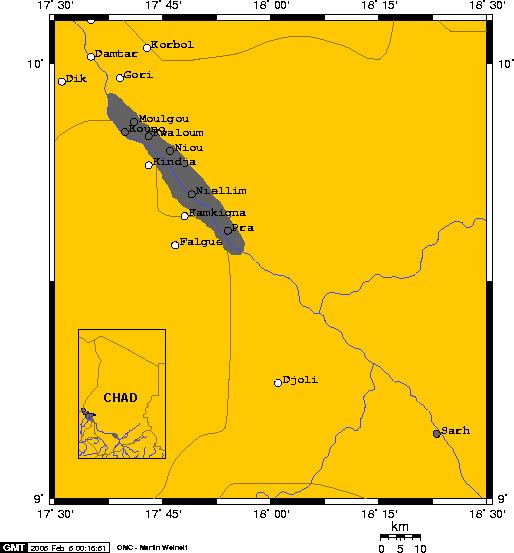ISO 639-3 nie | Native speakers 5,200 (1993 census) Glottolog niel1243 | |
 | ||
Language family Niger–CongoAtlantic–CongoMbum–DayBuaNiellim | ||
The Niellim language (autonym lwaà) is a Bua language spoken by some 5,000 people (as of 1993) along the Chari River in southern Chad. It is mainly spoken in two areas: one around the city of Sarh (to which many - perhaps most - speakers have migrated) and one, its traditional home, further north, between about 9°30′ and 9°50′ N, corresponding to the former chiefdoms of Pra, Niellim, and Niou.
Contents
Niellim borders on several languages of diverse families – in particular Sara, Ndam, and Laal – and is influenced by the local lingua franca, Baguirmi; it has itself strongly influenced Laal, but also apparently has been influenced by Laal, or a relative of Laal, since much of the common Laal–Niellim vocabulary is not Bua. It is notably homogeneous. As a small minority in Chad, its speakers usually have to learn other languages, mostly (as of 1974) Baguirmi, Sara, Arabic, and Bua.
Phonology
The consonants are:
The vowels are /i/, /ɨ/, /u/, /e/, /ə/, /a/, and /o/ as well as the diphthongs, /ja/ and wa; all except /ɨ/ can also be given contrastive length and nasalization. Complex vowel harmony, rather similar to that found in Laal, is observable.
There are three tone levels: low, mid, high. Any syllable must bear at least one tone; it may bear any combination of two tones, or one of three three-tone combinations: LML, MLH, or HLH.
Syntax
The typical word order is subject–verb–object (though this can be affected by topic fronting); preposition - prepositional object (- postposition); noun - adjective; possessed - possessor. However, possessive pronouns precede the noun.
Pronouns
The basic personal pronouns include: n "I", m "you", r "he, she, it" (with low tone as subjects, high tone as objects), í "you (pl.)", á "they". ("We" does not appear in sources so far examined by the editors.)
Nouns
Noun plural formation is quite complex, and includes some apparent relics of a now-absent noun class system; the commonest ways include combinations of internal vowel ablaut, the suffix -gɨ, a change l/n > r, and/or replacing final -a with -i.
Verbs
Each verb has two forms: indicative and optative ("injunctive" in Boyeldieu's terminology.) They are distinguished by tonal pattern.
Verbs may be preceded by various particles to indicate tense, aspect, and mood: for instance wò continuous, ɓə future, ká obligation. Indirect quoted speech is preceded with the particle ɓə "that".
Verbal nouns may be formed by changing the tone pattern and/or suffixing -li or -la (in which the l becomes n following a nasal) together with internal vowel ablaut.
Verb derivational suffixes include -n intensive (realized as -nì or -ɨ̀n, e.g. nun "bite" > nùnɨ̀n "gnaw", and sometimes causing internal ablaut), and -gɨ̀ mediopassive (sometimes -gi or -gu, rarely causes internal ablaut).
Prepositions
Common prepositions include gɨ̀ "to (dative)", naà "with", ti "to".
Examples
(From a story recounted by Dakour Yalka Ali, in Boyeldieu 1985, p. 10)
